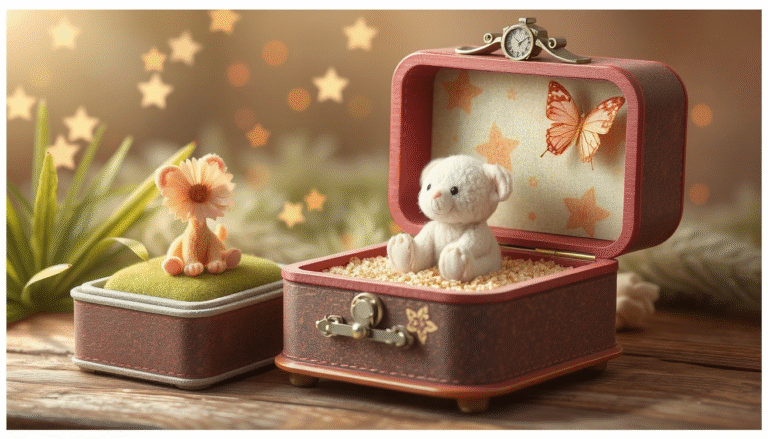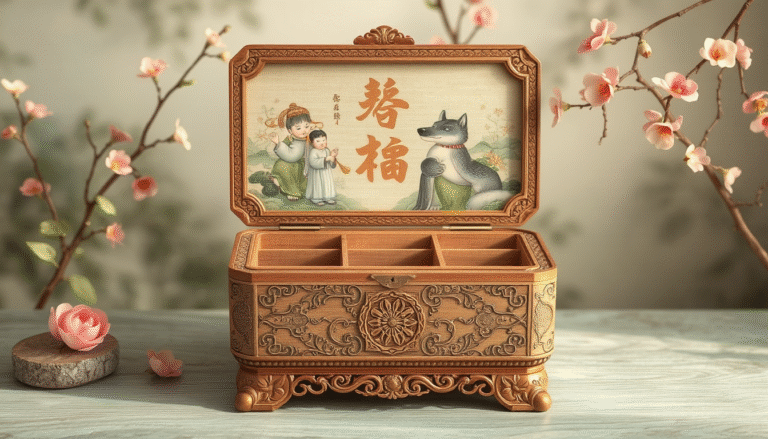Introduction
Touching history I touch history holding an antique Chinese jewelry box. It begins with the sweet scent of timber decades old, preserved for more than a century. The smoothness of jade or of carved designs can be felt. Brass components glow in the light, suggesting treasures within.
These boxes are more than just boxes. They are petites oeuvres that speak to much larger stories through their materials, workmanship, and symbolism. For collectors, decorators or the simply curious, these boxes afford a glimpse of Chinese art.
This guide is your everything. We’ll explore the history that shaped these boxes, peer deep into the materials and tell you how to read its decorations. Jewelry Box A Chinese jewelry box is not just for jewels, the jewelry box is itself one of a jewel.
A Journey Through Time: The History of the Chinese Jewelry Box
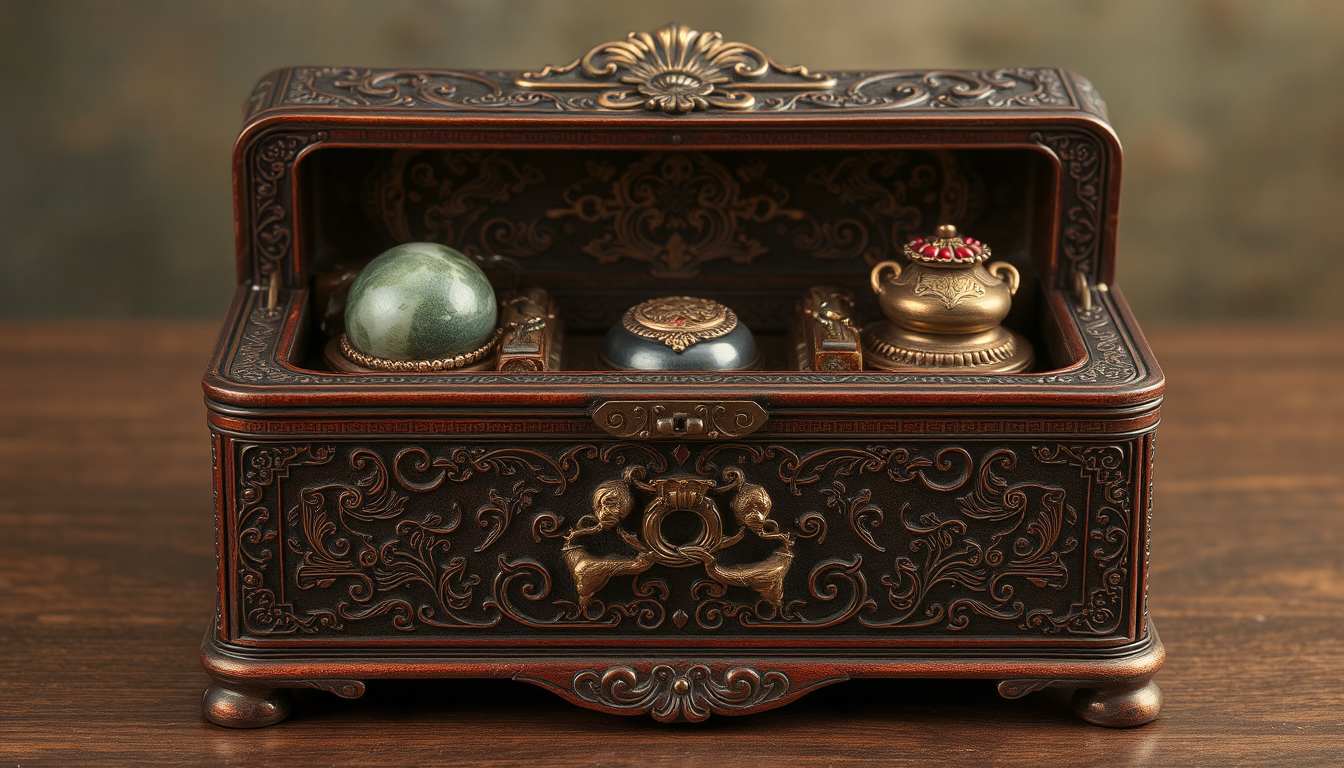
The story of Chinese jewelry boxes is long and impressive. These boxes changed over centuries from simple storage to status symbols and wedding gifts. To truly value an antique, you need to know when it was made.
From Imperial Courts to Family Heirlooms
Vintage boxes for precious items Antique and vintage boxes for precious items such as pocket watches, jewellery and snuff boxes were made from various materials. The craft blossomed during China’s later imperial periods. It wasn’t until the Ming and Qing dynasties that the classic designs that we know today became favored by emperors and master craftsmen.
The Qing Dynasty (1644-1912) saw the best of this art form. During the reigns of emperors Kangxi and Qianlong, royal workshops made incredibly complex and beautiful decorative items. This time is known for amazing mastery of techniques like carved lacquer, which shows up in the finest jewelry boxes.
Originally crafted for emperors and nobles, these boxes eventually gained importance as family heirlooms by wealthy merchant and official families. A jewelry box formed part of a bride’s dowry: It signified her wealth and her family’s standing.
-
Tang Dynasty (618–907): The richer started to have fancier boxes (often with precious metals) and also new kinds of decorations.
-
Ming Dynasty (1368–1644): Elaboration was applied in particular to woodworking crafts and lacquer ware.
-
Qing Dynasty (1644–1912): The apogee of elaborate, ornate designs, inlaid work, intricate carving, and expensive materials.
The Soul of the Box: Understanding Materials and Craftsmanship

An antique Chinese jewelry box is only worth as much as the quality of its materials and the level of craftsmanship required to produce it. Be familiar with to look for them is often the first step to being a good collector. Every decision from the type of wood, to the finish applied, to the hardware used was thoughtfully chosen to both enhance the box’s beauty and its significance.
The Foundation: Precious Woods
The selection of wood provided the box with its substance and its soul.”
Rosewood (酸枝木, Suānzhīmù):Reddish-brown with black grain, very valued for the rich tone of its strong’ wood’. This tough, durable wood shines up beautifully and frequently offers a mild, fragrant aroma.
Camphor (樟木, Zhāngmù): Known for its powerful, clean smell. Camphor wood was so prized because it would naturally repel insects that it was perfect for those boxes designed to protect silks, among other things.
Zitan (紫檀, Zǐtán) & Huanghuali (黄花梨, Huánghuālímù): The wood of these two species of woods is highly treasured as the rarest in Chinese furniture. Zitan is a very dense wood with a dark purple-black color…Huanghuali has a warm honey color and lovely grain patterns. Boxes from these timbers were generally for the royal court and are therefore rare.
| Wood Type | Color & Grain | Key Feature | Common Use/Value |
| Rosewood | Reddish-brown, dark grain | Dense, durable, aromatic | High-quality furniture & boxes |
| Camphor | Yellowish-brown | Strong, moth-repellent scent | Lining for boxes, storage chests |
| Huanghuali | Honey-brown, “ghost face” patterns | Extremely rare, luminous | Imperial-grade, collector’s items |
| Zitan | Dark purple-black | Densest hardwood, polishes well | Imperial-grade, museum quality |
The Finish: Lacquer and Cinnabar
Lacquer paints are not really just a mere coating. It’s hardened sap from a special tree, spread in many thin layers. One layer must dry entirely before the next gets added, a process that can last for months.
This finish might be either a shining black or red, painted with delicate scenes, or carved very deeply. This kind of intricate carving, called Tiaohu (剔红), makes for an incredible 3D effect.
Cinnabar (朱砂, Zhūshā)is the best-known type of carved lacquer. It is the deep red lacquer, tinted with the mineral cinnabar, carved with intricate scenes, flowers and designs.
The Embellishments: Inlays and Fittings
The final artistic touches came from decorative additions.
Mother-of-Pearl & Jade:Slim, shiny squares of mother-of-pearl were painstakingly worked and placed on the lacquer or the wood to create dazzling pictures of people, birds and flowers. Jade, a stone associated with purity and rank, was commonly used for the inlay panels, locks or the handles.
Brass & Bronze Hardware: The hardware was a strong part of the design. Openings were removed and handmade hinges, closures, pulls and corner pieces were crafted from brass or bronze. Search for specific shapes — such as cloud-shaped hasps or bat-shaped pulls, which had symbolic meanings of their own. If the Box is of good quality, it’s metalwork is so.
Reading the Art: A Guide to Decoding Chinese Symbolism
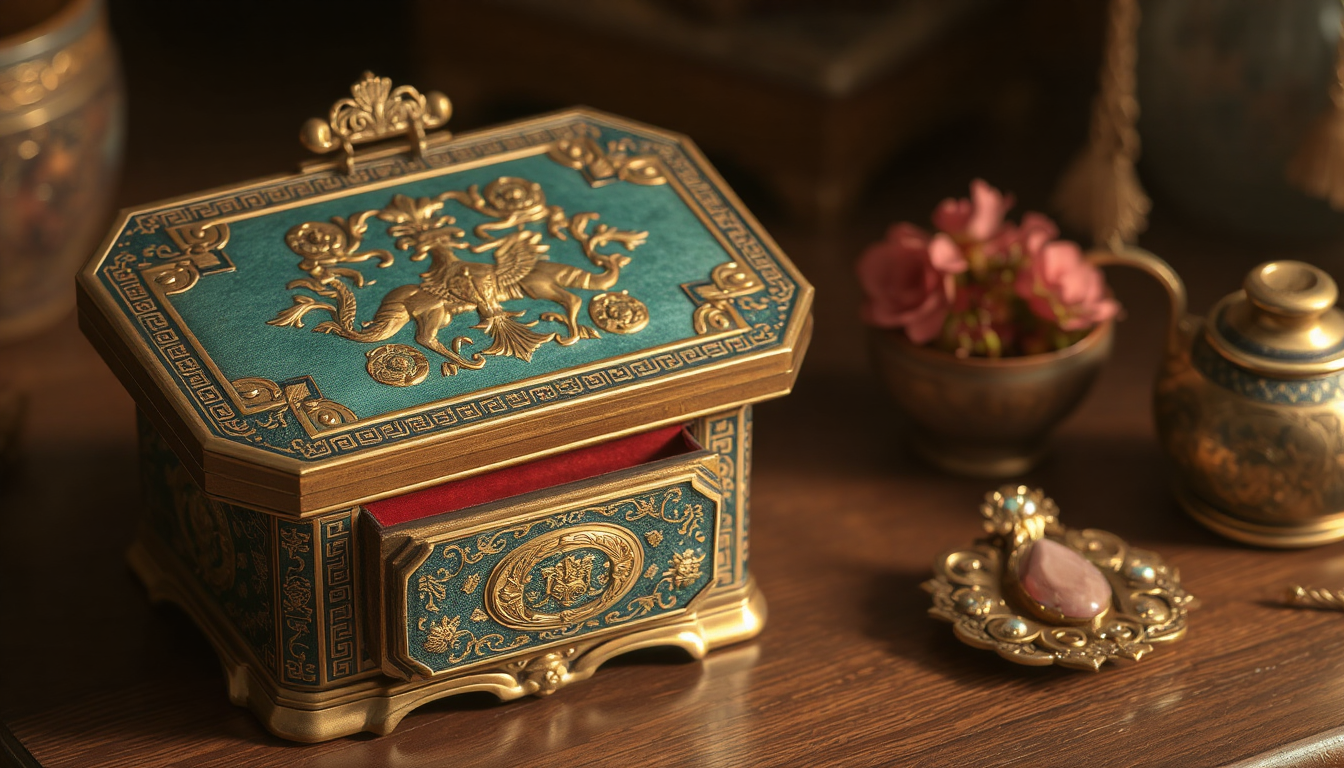
Every design on an antique Chinese jewelry box is part of a rich visual language that expresses good wishes and cultural values. Learning this language unlocks the deeper story of the piece, changing it from just a beautiful object into a meaningful story.
Mythical Creatures of Power and Fortune
-
Dragon (龙, Lóng): The very essence of imperial authority, power, force, and good luck. The dragon is symbolic of the Emperor and masculine energy.
-
Phoenix (凤凰, Fènghuáng): The mythical queen of the birds, representing the Empress, beauty, and virtue. When the dragon and the phoenix are combined they bring about wedded bliss.
Flora and Fauna: The Natural World’s Blessings
-
Bat (蝠, Fú): A powerful symbol of good luck, as its name sounds like the word for fortune (福, fú). Five bats together is especially lucky, representing the Five Blessings: long life, wealth, health, love of virtue, and a peaceful death.
-
Peony (牡丹, Mǔdān): The peony is a “flower king” and a symbol of wealth, high social status, and romantic love. Its fermeté state is associated with abundance and esteem.
-
Lotus (莲花, Liánhuā): Rising pure and unsullied from water or mud, the lotus is a profound symbol of purity, spiritual growth, and rendering adversity beautiful.
-
Crane (鹤, Hè): It is said that cranes can live a thousand years, and this constitutes a major motif of long life and wisdom.
-
Fish (鱼, Yú):The character for fish is pronounced similar to yu or abundance (余, yú), and therefore people like to use the fish for abundance or wealth.
Symbols of Longevity and Prosperity
-
Shou Character (寿):The shou character itself in addition to being a character for longevity is a strong decorative motif. There are many stylized versions of this motif (sometimes as part of other designs).
-
Coins & Ruyi Scepter: The ancient Chinese coins with square holes are the ultimate symbols of wealth. Being curved and to have carvings on one end, the Ruyi scepter represents the wish-fulfilling scepter.
The Collector’s Eye: How to Identify and Authenticate an Antique Box
Telling a real antique from a modern copy takes a trained eye and careful approach. This checklist, based on what appraisers do, will help you evaluate any potential purchase with confidence. These aren’t just decorative items; they have a rich history you can learn about by looking at visual examples of historic pieces.
Step 1: Examine the Overall Form and Construction
Patina and Wear:A genuine antique will have a beautiful patina — the warmth that comes from decades of handling. This can’t be faked well. Wear should be logical, and should correspond to the way the box was used. What you can expect: More rubbing on the edges, front clasp and base, less on the back panels.
Joinery:See how they’re putting the box together. Fine antique Chinese boxes were made using intricate joinery, such as hand cut dovetail joints. Beware of pieces held together with modern glues, nails or, worst of all, Phillips-head screws.
Step 2: Inspect the Materials and Artwork
Wood:So, feel the weight of the box. Does it sound correct for the species of wood? The rosewood and Zitan are extremely heavy; the camphor is far lighter. If you can, sniff the inside of the drawers to see if they smell like camphor.
Lacquer: Authentic antique lacquer may have fine lines of cracking or “craquelure. It’s from the wood itself expanding and contracting from decade after decade of doing so. If you have a new varnish it’s likely to have a flat, plastic looking shine.
Inlays:Look at the inlay work very carefully. Real inlays of mother-of-pearl were cut and hand-fit, with minor variations and gorgeous detail. (Most modern reproductions employ machine-cut pieces that appear flat and mechanistic.
Step 3: Check the Hardware and Interior
Hardware: The hardware itself is a critical clue. Solid brass or bronze fittings are hand-forged and may feature some slight variances in size, modest hammering, or minor asymmetries. Machine-made contemporary hardware is so uniform and often too bright and thin.
Lining: Inside can be just as open as outside. The original silk linings are quite delicate. They are often stained, worn or damaged. It is certainly suspicious that a perfect, bright silk lining has survived inside a box that is said to be 150 years of age, although it may be a later replacement.
Step 4: Red Flags of Fakes and Reproductions
Beware of the obvious tricks to make yourself appear older. This needs help from someone who knows what they’re looking at, because you get uniform sandpaper scratches, or something like dark paste, often over shoe polish, smeared on to resemble patina. A piece is not antique if there are any obvious Phillips-head screws or modern staples. Finally, markings should be hand-painted or stamped on the bottom, not printed paper stickers.
Preserving Your Treasure: How to Care for Your Antique Jewelry Box
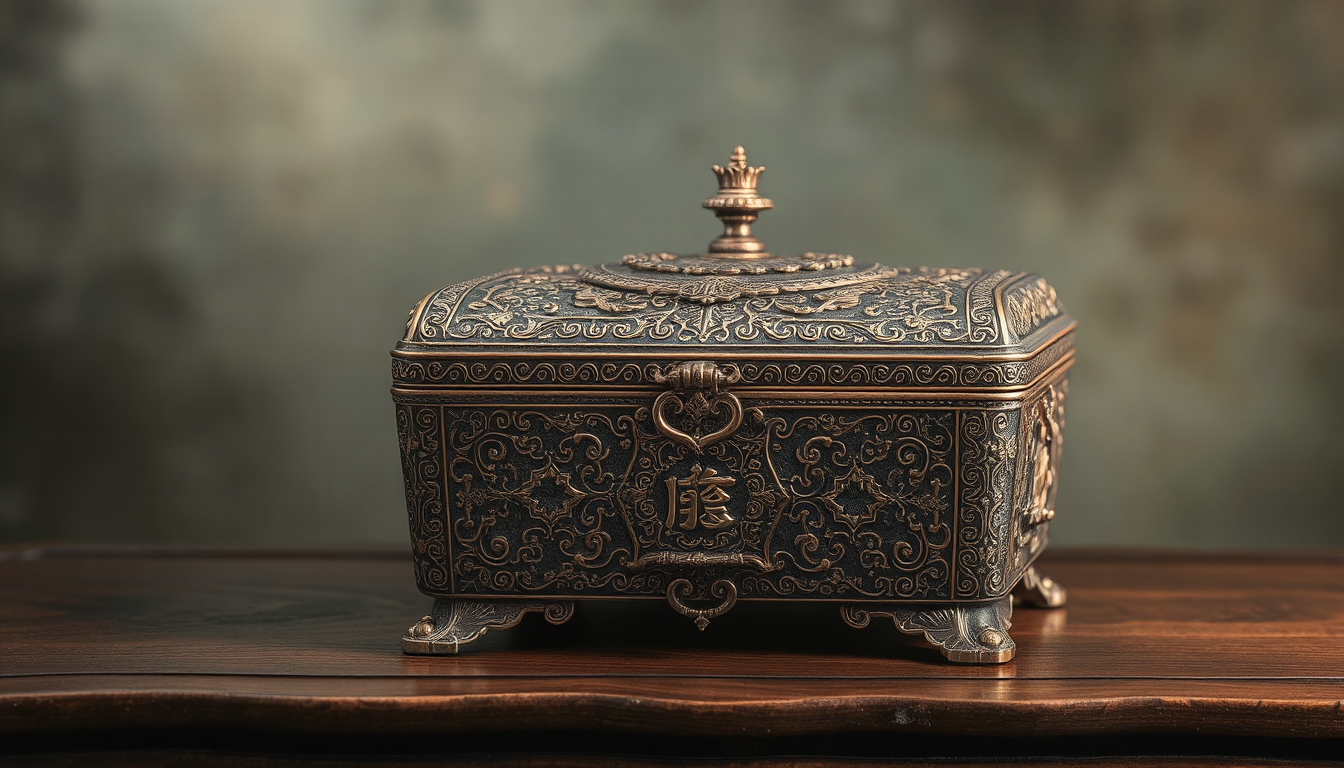
Once you own an antique Chinese jewelry box, you become its caretaker. Proper care is essential to preserve its beauty and value for years to come. The main rule is always “less is more.”
The Do’s and Don’ts of Cleaning and Display
DO:
-
Wipe surface lightly with clean, dry microfiber cloth. This is about all the cleaning that is necessary.
-
Store the box out of the direct sun. The UV rays will cause the lacquer to fade and dry the wood out, leading to cracks.
-
Maintain a stable environment. “Woods like a medium to even coarse moisture content of roughly 45 to 55 percent. Keep out of extreme temperatures- such as in an attic or damp basement.
DON’T:
-
Avoid commercial furniture polish, waxes, and sprays and any cleaners that contain alcohol, water or ammonia. These are highly corrosive chemicals that will eat into the original finish and raise the lacquer.
-
Don’t put hot mugs, wet glasses or anything plastic directly on the surface, as they can leave behind permanent marks.
-
Don’t force a stuck drawer or repair broken hardware on your own. Consult with a specialist in Asian decorative art who is a professional conservator.
Conclusion: A Legacy in Your Hands
A vintage Chinese jewelry box is an extraordinary object, combining history, art and the personal touch. It is crafted from fine metals by skilled artisans and (brings meanings eternal love, strength, and protection to the one who wears it.
When you pick up one of these pieces, you are holding something more, a box. You are guarding a story — whether it’s the story of a bride on her wedding day, an official in the royal court, or a family’s greatest hopes. We want you to have pride in these treasures in their own right, not only for their beauty, but for the precious culture they represent – a culture that is now in your hands to preserve and pass down to future generations.
FAQ
-
What makes an antique Chinese jewelry box valuable?
The value derives from the materials (such as rare woods like zitan or huanghuali), workmanship (hand-carved lacquer, intricate inlays), age (especially Ming and Qing dynasties), condition and provenance. -
How can I tell if my Chinese jewelry box is authentically antique?
Check the patina (natural age), joinery (hand-cut dovetails), hardware (hand-forged brass/bronze has minor imperfections) and the materials (real woods have their weight/scent). Stay away from the modern screws and overall wear. -
What symbols are commonly found on antique Chinese jewelry boxes?
Look out for dragons (imperial power), phoenixes (feminine virtue), bats (good luck), peonies (wealth), lotus flowers (purity) and the shou character (longevity) – each with its own cultural meanings and laden with good luck. -
How should I care for my antique Chinese jewelry box?
Store in the shade or not in direct sunlight, stable humidity (45~55%), dust with a dry microfiber cloth, NO commercial polishes or cleaners ever, consult professionals for any hardware or structure repairs. -
What are the most collectible periods for antique Chinese jewelry boxes in 2025?
Pieces from the late Ming Dynasty (16th-17th century) and Qing Dynasty (Kangxi and Qianlong periods, 1662-1795) continue to be the most desired, with museum-quality examples from these periods fetching top prices in today’s collecting market.



